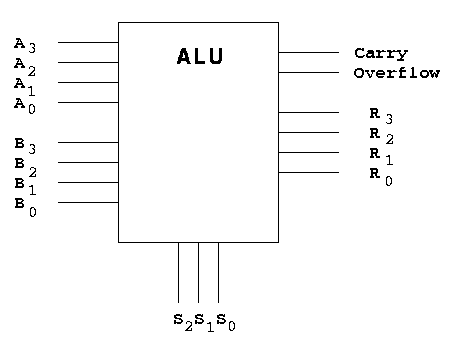Introduction to Microprocessor
8085 Microprocessor Definition: When we hear the word microprocessor then what comes to our mind is a small (i.e-micro) IC that can process data i.e- perform airthmetic and logical operations. Microprocessor reads the instructions from memory and excutes it line by line.
As we know that all of this operation is performedGenerally all of this operation is done by the ALU unit in Microprocessor.
by the CPU in a large computer.
So we can compare the CPU and ALU as the fig. given below.


ALU:-This section is used for performing the airthmetic and logical operation in Microprocessor. Here A and B are the input pins where operands are put on which we want to perform airthmetic and logical operation. A and B section are operand section and it processes it according to the given instruction.

Airthmetic operation:- Like addition, substraction,multipllication,division etc.
Logical Operation:- Like AND,OR,NOT,EX-OR etc all logical operation.
Opcode:- A Binary code that indicates the operation to be performedis called as an opcode.
Operands:- The data on which the operation is to be performed is known as operand.
Instruction:-The combination of opcode and an operand,that can be used to instruct a system is called as an instruction.
Instruction set:-A list of all the instructions that can be issued to a system is called as instruction set.
Program/Subroutine/Routine:-A set of instructions written in a particular sequence,so as to implement a given task. A subroutine in assembly refers to function as in C/C++.
Bus:-A group of lines, pins or signal s having commons functions is termed as the bus.
There are three buses in 8085 Microprocessor:
1. Data bus- Microprocessor has 8 bit data bus. It carries data(to receive and to transmit) from memory or to memory.
2. Address bus-Microprocessor has 16 bit address bus. Generally it is used to select the memory or I/O location through which we want to communicate the microprocessor.
3. System bus-It provides control and timing signal to perform the various operation.
Memory:-Generally a memory is used for storage purpose. We can store the data,instruction sets etc. Instruction sets are stored in memory in form of binary number. It provides that information to Microprocessor whenever necessary. Microprocessor reads instructions from memory and performs the operation in its ALU section. Results are transferred to Output Section(LCD display,LED, others). It may also stored in memory as it needs.
There are two types of memory:
RAM(Random Access Memory)- It is a type of memory. it provides the reading and writing both facility.
ROM(Read Only Memory)-Data or program stored in ROM can only be read. It can not be altered. It doesn't provide the writing facility.
